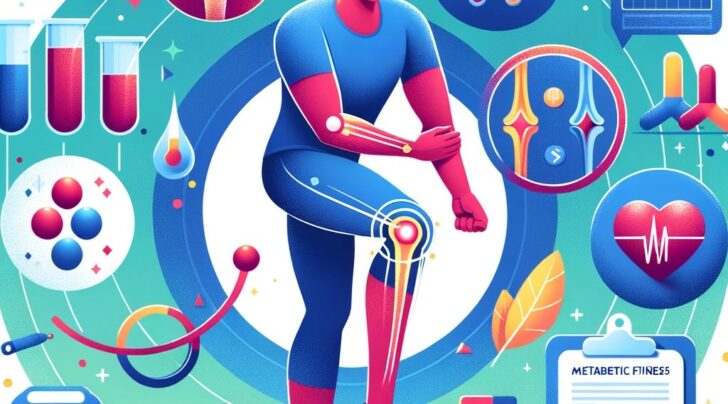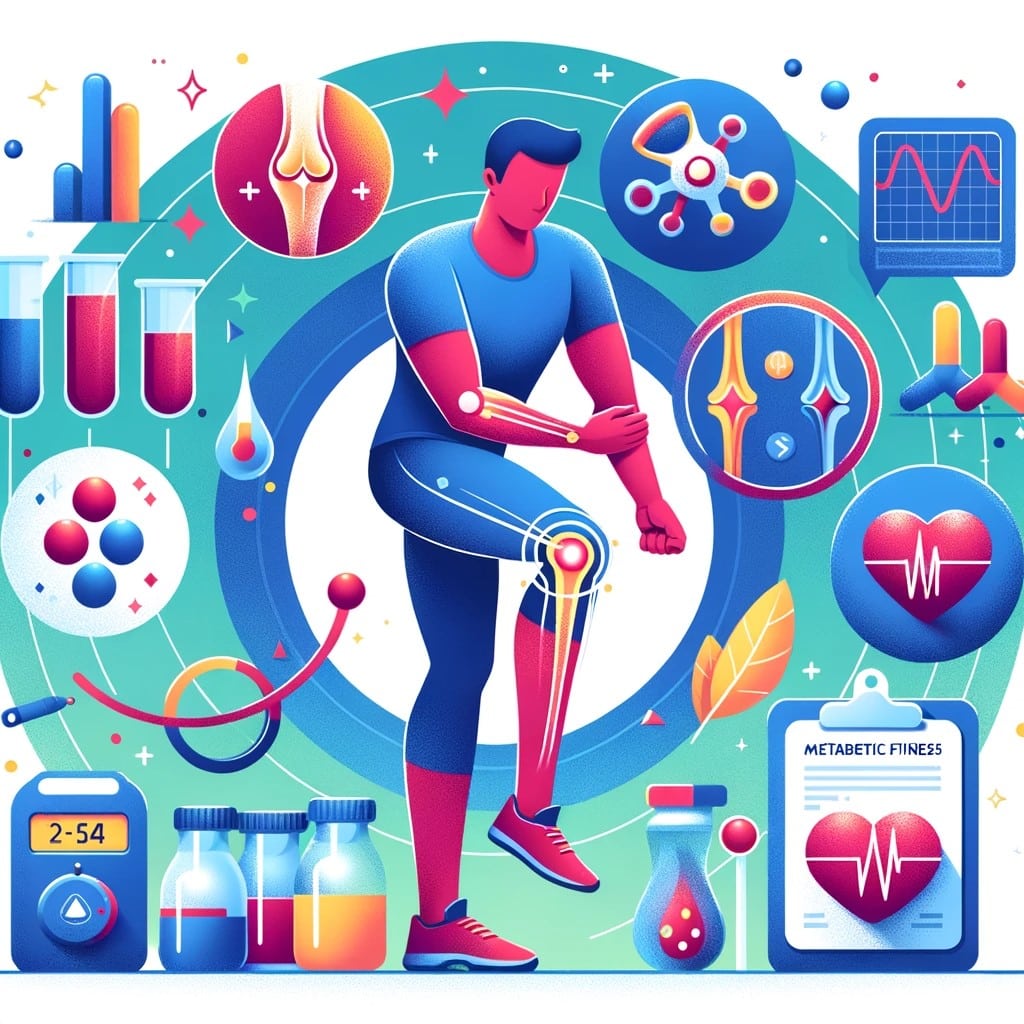
In the realm of orthopedic health, joint issues stand out as common afflictions troubling a significant portion of the population. While traumatic injuries and genetic predispositions are well-recognized contributors, there’s an increasing awareness of the role played by lifestyle factors, particularly sedentary behavior and poor metabolic health. This article delves into how these elements exacerbate joint problems and intensify pain, offering insights into mitigating their impact through lifestyle, exercise, or medical interventions.

The Rise of Sedentary Lifestyles
In our technology-driven world, sedentary lifestyles have become the norm. Despite the fact that human history reveals that activity was the norm and not viewed as an intervention. Today, exercise is viewed as an intervention. Extended periods of inactivity lead to inflammation, loss of muscle mass, muscle weakening, and loss of balance. The chronic inflammation associated with metabolic disease sucs as insulin resistance, type 2 diabetes, metabolic syndrome, etc has profound impact on all the tissues within our body, including our joints, muscles and tendons.
The Metabolic Connection
Metabolic health, encompassing factors like blood sugar levels, abdominal adipose, and cholesterol, is crucial in joint health. Conditions like diabetes and hyperlipidemia are known to cause systemic inflammation. This inflammation exacerbates joint pain and accelerates the degenerative process in joints. High glucose levels in diabetes can lead to the formation of advanced glycation end-products (AGEs), which stiffen collagen in joints, making them more prone to pain, stiffness and damage.
The Cycle of Pain and Inactivity
Pain in the joints often leads to reduced physical activity, creating a vicious cycle. Reduced activity exacerbates metabolic conditions, which in turn increases joint pain. This cycle can be challenging to break, especially without the right guidance and support.Much of this discomfort is due to inflammation. The majority of that inflammation is due to poor metabolic health. Exercise improves our overall health, as well as the health of the joint being exercised. By decreasing chronic inflammation, exercise improves both our overall health, as well as the health of our joints.
Breaking the Cycle: Lifestyle Interventions
Exercise and Physiotherapy
A cornerstone of managing joint issues is exercise. Strength training focusing on supporting muscles can significantly reduce stress on these joints. The more capable your muscles are at propelling you across the landscape, the less force there is on our joints.
Exercise: The Essential Tool in Joint Health Management
In the management of osteoarthritis, the role of exercise cannot be overstated. Contrary to the outdated notion that rest is the best response to joint pain, current medical consensus emphasizes the critical importance of physical activity. Adopting a sedentary lifestyle can exacerbate joint issues, while regular exercise offers numerous benefits that significantly outweigh the risks associated with physical activity.
Debunking the Myth of Rest
The idea that rest is the best medicine for osteoarthritis is a misconception that can lead to detrimental outcomes. Prolonged inactivity not only leads to muscle atrophy and joint stiffness but also contributes to the progression of osteoarthritis, and more importantly, it worsens our metabolic condition. Muscles and joints thrive on movement; without it, they weaken and deteriorate more rapidly.
The Benefits of Exercise
Regular exercise is a cornerstone in properly managing knee, hip and shoulder pain for several reasons:
- Stronger joints generally feel better.
- Knee surgeons have known this for years. The strongest patients in our practices, keep their natural knees the longest.
- Exercise improves metabolic health, decreases chronic inflammation, lessens the risk of progression, and improves pain.
- Not all pain implies harm. Most of you should feel comfortable exercising despite mild discomfort.
Overcoming the Fear of Activity
Many patients with joint pain fear that exercise will exacerbate their symptoms. However, the risks associated with sedentary behavior far outweigh the risks of activity. It’s important to start with low-impact exercises and gradually increase intensity under the guidance of a physical therapist or a trained professional. Activities such as swimming, cycling, and strength training are excellent options for people with joint issues.
Developing a Sustainable Exercise Routine
Creating a sustainable exercise routine is key. It should be tailored to individual capabilities and limitations, with a focus on strengthening and flexibility exercises. Consistency is crucial – regular, moderate exercise is more beneficial than sporadic, intense workouts.
Dietary Changes
An anti-inflammatory diet can play a pivotal role in managing joint health. Foods rich in omega-3 fatty acids, antioxidants, and phytonutrients help reduce inflammation. Conversely, processed foods, high in sugars and unhealthy fats, should be limited as they can exacerbate inflammatory processes.
Medical Interventions
While lifestyle changes are fundamental, medical interventions are sometimes necessary. These may include anti-inflammatory medications, corticosteroid injections, and in more severe cases, surgery. However, these are typically considered after lifestyle interventions have been explored.
The Role of GLP1 Medications in Managing Joint Health
In recent years, GLP1 (Glucagon-like peptide-1) medications have emerged as a game changer in the field of metabolic health and, by extension, in the management of osteoarthritis, particularly in the knee and hip. Originally developed for the treatment of Type 2 diabetes, these medications have shown remarkable efficacy in improving metabolic and inflammatory profiles, which in turn has a profound impact on joint health.
Understanding GLP1 Medications
GLP1 medications function by mimicking the action of the natural hormone GLP1, which plays a key role in regulating blood sugar levels. They enhance insulin secretion, reduce glucagon production, and slow gastric emptying, thereby improving glycemic control. Additionally, these medications have a significant impact on weight loss, which is a beneficial side effect, especially for individuals with joint issues.
Impact on Metabolic and Inflammatory Profiles
One of the critical ways in which GLP1 medications benefit joint health is by improving the overall metabolic profile of individuals. By enhancing insulin sensitivity and promoting a healthier lipid profile, these medications reduce the systemic inflammation that contributes to the deterioration of joint tissues in osteoarthritis. Reduced inflammation not only slows the progression of joint damage but also significantly alleviates pain.
Pain Relief and Improved Joint Function
Patients on GLP1 medications often report a marked decrease in joint pain and an improvement in joint function. This effect is attributed to the anti-inflammatory action of the medications, which goes beyond mere weight loss. By targeting the underlying metabolic dysfunctions that contribute to joint degeneration, GLP1 medications offer a more holistic approach to managing osteoarthritis.
Do you have questions regarding an Orthopedic injury or longevity?
Do you want to talk to an expert who can listen to you for 45-60 minutes and explain the options in detail?
Dr. Howard Luks offers remote guidance sessions to review your X-ray or MRI images and explain your options.
Dr. Luks has also received hundreds of requests for educational sessions on the topics discussed in his book, Longevity Simplified.
Implications for Osteoarthritis Management
The implications of these findings are substantial. For individuals struggling with joint pain due to osteoarthritis, GLP1 medications offer a dual benefit – improving metabolic health and directly contributing to pain relief and joint preservation. This positions GLP1 medications as a crucial tool in the multifaceted approach to managing knee and shoulder osteoarthritis, especially in patients with underlying metabolic conditions.
Integrating GLP1 Medications into Treatment Plans
Whether or not GLP1 medications represent a significant advancement in the treatment of osteoarthritis remains to be seen. The plan to improve our overall health should include lifestyle modifications, physical therapy, and, where necessary, other medical interventions. Patients considering GLP1 medications should consult with their healthcare provider to understand the potential benefits and to determine if these medications are appropriate for their individual health profile.
The importance of exercise in managing knee and shoulder osteoarthritis cannot be overstated. While rest might seem like a safe approach, it often leads to increased pain, stiffness, and further joint deterioration. Exercise, on the other hand, offers numerous benefits that extend beyond joint health, contributing to overall physical and mental well-being. Embracing an active lifestyle is essential not only for managing osteoarthritis but also for preventing its onset and progression. By challenging the outdated notion of rest and embracing the power of movement, individuals with osteoarthritis can take a significant step towards better health and improved quality of life.
Joint problems are often exacerbated by factors within our control. Sedentary lifestyles and poor metabolic health contribute significantly to these issues. By understanding the role of these factors and taking proactive steps to address them, individuals can effectively manage and even prevent joint problems, leading to an improved quality of life and reduced reliance on medical interventions.
This approach to orthopedic health underscores the importance of a holistic perspective, where lifestyle choices are recognized as pivotal in managing physical well-being. It empowers individuals to take charge of their health, offering a path to not just pain relief but also enhanced overall health and vitality.











